Diamond crown on concrete: properties, features, application
Diamond drilling of holes in concrete is one of the most effective technologies for cutting superhard and reinforced building materials, which allows to obtain even holes of the required diameter with high precision. We will tell you what diamond crowns are made of reinforced concrete and what they are used for.
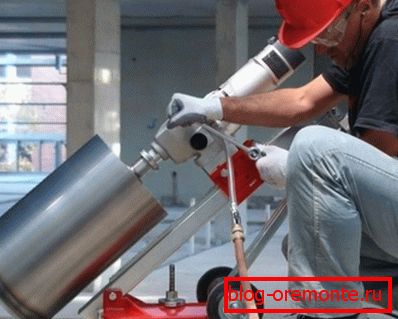
Diamond cutting holes
General information

The technology of diamond cutting appeared relatively recently - at the end of the last century. However, the widespread dissemination of reinforced concrete as the main structural material, the popularity of monolithic construction and the increasing quality requirements for the work performed, have led to the fact that such cutting has recently become the main way of solid reinforced walls and other structural elements.
The main difference of diamond drilling from the traditional one is that in the course of work, vibration and shock action are not used. As a result, the holes are obtained as neat and smooth as possible, without chips and cracks.
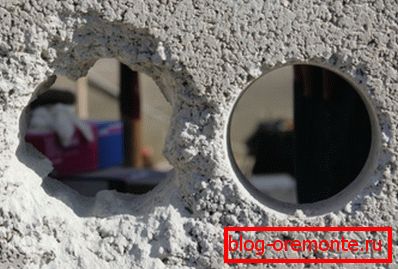
In addition, the sound load is significantly reduced, which is a serious disadvantage of the use of perforators and chippers. The operator can safely be located near the installation without earplugs or headphones, and the surrounding workers do not tolerate the inconvenience associated with noise.
The principle of operation also differs: it does not refer to conventional auger drilling or perforation, but rather a process similar to cutting with a circular saw. Attention should be paid to the fact that when the material passes by the screw, the tool must destroy and remove concrete from the entire volume of the hole, and this significantly increases the energy consumption, the thermal effect of friction and equipment wear.
Note! During diamond drilling, only a small amount of material is destroyed along the border of the hole, and then, together with the crown, a solid cylinder is removed from the stone. This significantly reduces the load on the tool, energy consumption and the thermal effect of friction.

The main working tool for drilling holes in reinforced concrete is a crown, which is a segment of a cylindrical pipe made of tool steel, to the end of which special cutting segments with a diamond coating are soldered. Also there are models with a solid diamond cutting edge.
At the opposite end of the tube is a shank with a connecting element for attachment to the rotating shaft of the tool. The range of such crowns is quite diverse due to the many modifications, lengths and diameters, as well as due to the different type of equipment of the end face with cutting segments for various materials.

Choosing the most appropriate type of crown is an important task, which will determine the performance and quality of work, as well as tool wear. Given the fact that the price of such a tool can be quite high, the wear factor directly affects the cost of work.
Cutting tubes can be mounted on a hand tool, and the electric drill should have a mode of operation without vibration and beating, and they are also used in conjunction with special installations for cutting holes, both mobile and stationary. As a rule, work with installations is made by trained operators, as the equipment is expensive and requires adherence to a certain technique when used.

When using installations it is important to properly prepare the process. The instruction requires fixing the tool with anchors, bolts or other fasteners to eliminate the possibility of jamming, horizontal beats and other undesirable phenomena during operation. It also greatly improves the cutting accuracy.
Types and device crowns
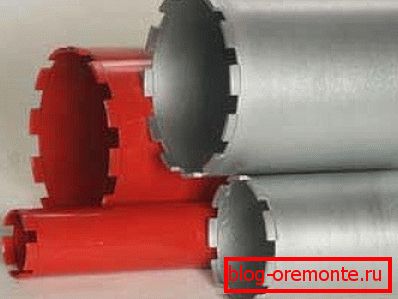
Diamond crowns for concrete are presented in a wide model range. One of the main distinguishing parameters is the diameter of the hole that the tool is capable of providing.
So, there are varieties of small and small sizes - 4 - 12 mm, which are used for cutting holes for electrical wires and communication communications.
You can also find crowns of medium size - 35 - 82 mm, which are used most often for the repair of apartments and laying of cable channels, pipes, installation of air vents, etc. They are also often used to cut holes and install flush-mounted plates that have a diameter of 68 mm or 82 mm.

Models of large dimensions (diameter 150-400 mm) are used for laying utilities, pipelines, installation of industrial equipment, etc. The tool of especially large sizes can reach 400 - 1200 mm in diameter, for its use they use high power installations.
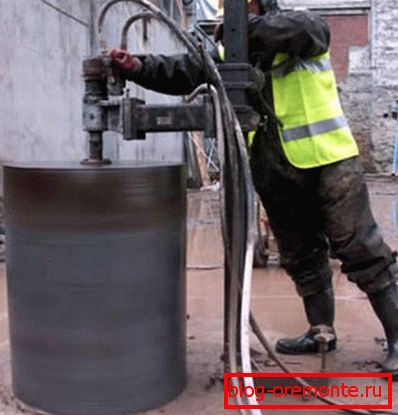
In addition to the diameter, an important characteristic is the length of the tube, since the depth of drilling depends on it. Lengths can be very different, but most often use a tool with a length of 400 - 450 mm. For the passage of blind holes or when working with thin partitions, crowns 300 mm long are also often used.
Models whose length exceeds 500 mm are mainly used for laying pipes and cutting thick-walled structures - foundations, reinforced concrete blocks, supports, hydraulic structures, etc. To work with such lengths, you also need special equipment and competent professional operators.

The next indicator, according to which the cutting tips differ, is the type of tooling. There are two main groups - for wet and dry drilling. They differ not only in the properties of the material, but also in some structural differences: the tool for dry cutting is equipped with special holes for cooling, whereas in wet cutting the cooling takes place with the help of water supplied to the drilling zone.
Finally, individual models, regardless of size and type, may have different types of tail anchorage. They come in different sizes and different ways of fixation, however, if a specific crown does not fit your instrument, you can use a special adapter.
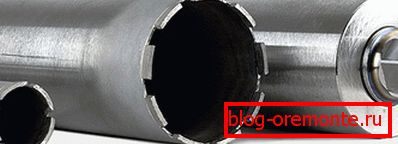
So, let's highlight the main parameters and differences:
- Diameter. There is a tool from 4 to 1200 mm in diameter, most often used tubes of medium size - from 35 to 120 mm. The presence of samples of different sizes allows you to accurately pick up a tool for a specific task, even if it is non-standard;
- Length. As a rule, for the passage of a wall or interfloor overlap, a medium enough length is 400 to 450 mm; however, for much more serious tasks, much longer specimens can be found. Models with a length of 300 mm or less are used to cut out non-through niches and holes for sockets;
- Type of equipment. There are various types of cutting segments and edges - soft and hard, frequent and rare, as well as solid. They allow you to select nozzles for various materials and types of drilling: for wet or dry passing, for concrete with dense aggregates, for materials with a high or low degree of reinforcement, for rocks with different abrasivity and strength;
- Mounting type. Various manufacturers of electrical equipment for drilling concrete use different types of fixing crowns on the shaft, so the nozzles themselves come with different fasteners.

Note! Models with cutting segments instead of edges are considered more profitable, since they can be restored after critical wear by soldering new segments.
Benefits and scope

The technology of drilling holes with diamond crowns has many advantages:
- Ability to work with reinforced concrete, which is not available for augers and perforators;
- High quality of the holes;
- Low noise level during operation;
- High performance and a small amount of slag and waste compared to other methods;
- Huge selection of working diameters and lengths, which allows you to accurately select the size of the tool;
- The absence of shock and vibration load on the structure, which makes the work safe even in emergency conditions;
- The ability to work with fairly large diameters without the use of special equipment and heavy duty equipment;
- Relatively low energy consumption.

This method of drilling is widely used:
- for laying wires, cable channels and pipes;
- for mounting air vents;
- for cutting curvilinear openings in walls;
- for dismantling work;
- for the passage of overlaps, repairs, installation of anchors and metal structures;
- and also for taking test cores during research and quality control of materials.
Note! For solving serious problems and passing large openings, thick concrete walls, structures with large reinforcement and hard rock aggregate, it is better to invite specialists for whom cutting reinforced concrete with diamond circles and drilling it is the main profession.
Conclusion
Для наиболее качественного, аккуратного и точного бурения отверстий в железобетонных и каменных конструкциях используют метод сверления алмазными коронками. Видео в этой статье позволит увидеть этот инструмент в работе и убедиться в его эффективности (см.также статью «Изготовление бетонных лестниц: порядок работы»).